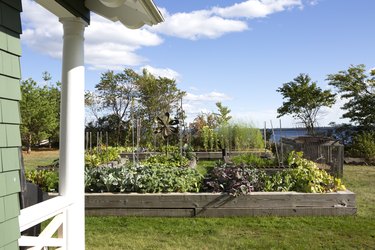If you ask 100 people about their experiences with vegetable gardening, their responses will be all over the map. Some will tell you it's the most rewarding hobby imaginable, while others will spin you a tale of woe about how difficult and frustrating the whole experience has been. The thing is, both of those "takes" - and all of the others in between - are equally accurate. The difference between a good and a bad experience usually comes down to how well you've thought it through. With that in mind, here are our best tips on planning a vegetable garden that works for you.
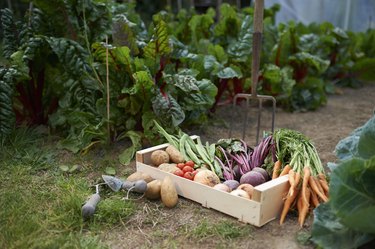
Video of the Day
Check Out the Available Space
Start by assessing the space that's available to you. Most vegetables do best in direct sun, though some will tolerate partial shade (or even appreciate it, in mid-summer). Watch for things like walls and trees that might shade your beds by late summer: you want at least 6 to 8 hours' direct sun per day. Now rule out the spaces that aren't practical to use, either because something's already there or because it would interfere with your normal use of the yard.
Video of the Day
The space that's left is your potential garden. You can use as much or as little of it as you choose, within practical limits. But what if you have little or no usable space? Well, you still have alternatives. Even a sliver of sunny space can be used for planters and container gardening, or you might take your aspirations off-site to a community garden or the home of an obliging relative.
Read Next: Container Vegetable Gardening for Beginners
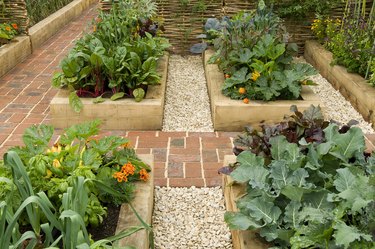
Assess Your Level of Commitment
This is where a lot of gardeners go astray. The more you want to grow, the more work is involved and the more time and effort you'll have to put in. To make an analogy, you can garden at the "taking a grandkid for ice cream" level or the "parenting five kids below school age" level. Matching your aspirations to your available time and energy will save you a lot of grief later in the summer.
A few small beds or planters may only require an hour of care, a few times each week. A garden large enough to feed your family might require 20 to 30 hours a week, and more during harvest time. If you don't currently have that many hours to spare, you may be taking on too much garden. Don't forget to allow for health and mobility issues, either. Neither is a deal-breaker, but you'll need to be conscious of your limitations and work within them.
It's always best to start small, and increase the size of your garden as you gain experience. Psychologically, building on success is a lot better than trying to rebound from failure.
Read Next: 9 Insanely Easy Hacks Every Gardener Should Know
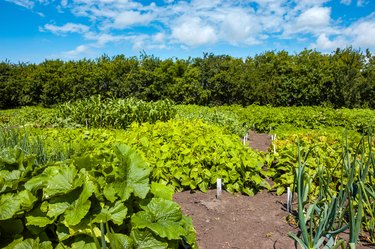
Choose a Style of Garden
Your next decision is which style of garden you wish to grow. There are several options, each with their own pros and cons. A short and (very) partial list includes:
Conventional In-Ground Beds and Rows
The traditional, "ordinary" garden most people think of when asked to picture a vegetable garden.
Pros:
- Well suited to large spaces
- Instructions on many seed packets and garden sites assume this is how you'll work
- Well-suited to the use of rototillers and cultivators
Cons:
- Not necessarily space-efficient
- Works best when your soil is fertile and well-drained
- Permanent or informal raised beds
- Can be labor-intensive
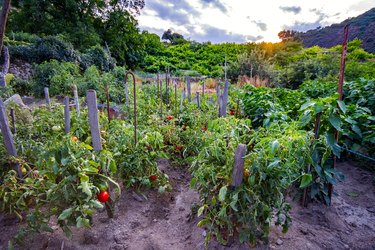
Permanent or Informal Raised Beds
Could be as simple as a frame of 2x4 lumber nailed together, or as formal as a well-built, waist-high cedar box.
Pros:
- Tall, permanent beds can be easier for the elderly and those with physical limitations
- Improves drainage
- Soil warms faster in spring (a bonus in cold climates)
- Neat appearance
Cons:
- Higher startup cost, especially for permanent beds
- Can require extra watering in hot/dry climates
- May require frequent additions of compost or other amendments to maintain fertility
Read Next: How to Build a Raised Bed Garden
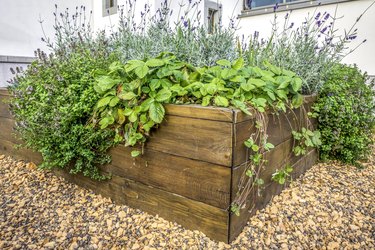
No-till Gardening
Instead of digging down, you build soil from the ground up by layering new topsoil, compost and mulch at ground level. Sometimes called "lasagna gardening," because of the way the layers build up.
Pros:
- Avoids issues with drainage and soil fertility
- Helps suppress weeds, build soil, and retain moisture
- A very low-effort approach to gardening, once you've got it started
Cons:
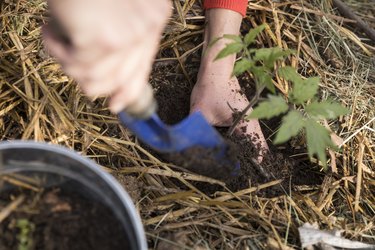
Square-Foot Gardening
One of several popular approaches to intensive gardening, which aim to grow the maximum of produce in a minimum of space. Developed by an engineer, it's a thoroughly rational and efficient technique.
Pros:
- Extremely efficient in its use of space
- Highly productive
- Frequently calls for mix-and-match planting, giving more variety in a given space
Cons:
- Requires extra planning
- Interplanting can make it more difficult to rotate your crops, a key step in minimizing pests and disease
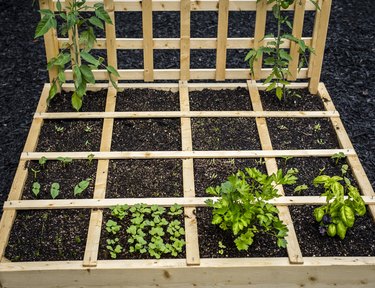
It's important to remember that these choices aren't either-or; you can mix and match to find a combination that works for you. It's perfectly possible, for example, to build up raised beds using the layered no-till method, and then follow the principles of square-foot gardening when you plan them.
Read Next: How to Layer Soil for Gardening
Choose Which Vegetables to Grow
If the harvest is the best part of the gardening year, then choosing what to grow is - at least - the best part of the planning stage. When winter has dragged on quite long enough, thank you, a few hours spent poring over seed catalogues is downright good for the soul.
Of course, it's not as simple as choosing everything that looks good and then pulling out your credit card. You'll need to account for a lot of factors, including:
- Your climate: Heat- and drought-resistance are important in the Southwest, while Midwestern and New England gardeners look for fast-growing, short-season varieties.
- Your level of expertise: Growing melons in Minnesota or cool-loving lettuces in a sweltering Southern summer requires extra skill and knowledge. Even cauliflower can be tricky, despite its lack of exoticism.
- Your soil: Is your soil light and sandy? Heavy with clay and slow-draining? A nice, balanced loam (if so, congratulations on your good fortune)? Does it have any notable deficiences, when tested at your local extension service? Vegetables are pretty adaptable as a rule, but some are decidedly finicky about the soil they'll flourish in.
- Your space: Some vegetables produce heavily from just a vine or two (zucchini are notorious for it), while others require a long row to give a decent-sized crop. The less space you have at your disposal, the more careful you'll need to be about how you use it.
- What you like to eat: You wouldn't think this gets overlooked, but it does. Your garden should only contain things that you and your family like, and will eat.
- Your goals for the garden: What are your ultimate goals for your garden? If it's to save on the grocery bill, plant things that are costly at the supermarket or that you eat lots of. If it's fresh salads all summer, go heavy on the leafy greens, tomatoes and cukes. If it's a full pantry and freezer for the winter, choose things that freeze, can or dry well.
Read Next: Vegetables that Grow in Shallow Soil
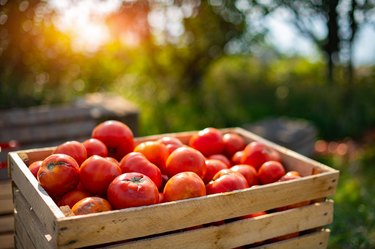
Plan the Physical Layout
Now that you've decided where you'll garden, how you'll garden, and what you're putting into it - in terms of time, effort and actual vegetables - the last step is to plan out what goes where.
Start by laying out the actual beds, whether they be in-ground or above ground. They should be no more than 3 to 4 feet wide (that's as far as most people can comfortably reach for planting, weeding and harvesting) and oriented north-south, to maximize the available sunlight. Allow at least a foot, and preferably 18 to 24 inches, between beds so there's enough room to walk, kneel and work. It's easier to visualize all of this if you draw the beds on graph paper, or use pegs and string to do them in situ at full size.
Read Next: 10 X 20 Vegetable Garden Plan Design
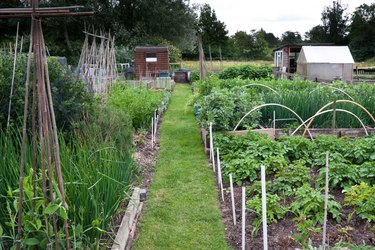
Plan What You'll Plant Where
Now, think about what goes where. As a general rule you should start with shorter plants at the south end and finish with taller plants at the north end, where they won't shade everything else. The calculus is a bit different if you're in a hot and sunny climate, because some plants might benefit from the shade. Also, if some of your plants (cucumbers, tomatoes, peas, beans) require support, you'll need to allow enough space for trellises or sturdy cages as well.
Finally, think about rotation. A few families of plants account for most of what we grow in our gardens: the brassicas (cabbage, broccoli, kale); the nightshades (tomatoes, potatoes, eggplants, peppers); the alliums (garlic, onions, leeks and their kin); legumes (peas, beans and peanuts) and cucurbits (squash, melons, cucumbers) are the main ones. Planting them in the same place year over year makes disease and insect pests a virtual certainty, so switch them around from one gardening season to the next.
At this point, you're ready to go get your hands dirty. The only thing left to do - aside from the actual gardening - is to record the decisions you've made, and the plants you've ordered, so you'll have a leg up on next year. Over time you'll forget what worked and what didn't, and this kind of impromptu journal (or a formal gardening journal, of course) will become a great resource.
Read Next: 17 Tips to Get a Vegetable Garden Growing
